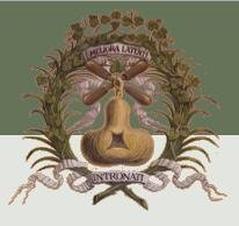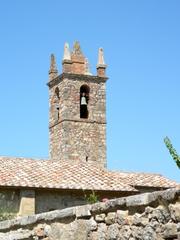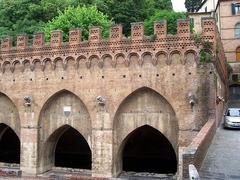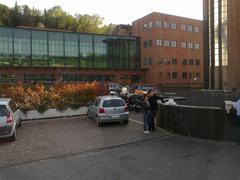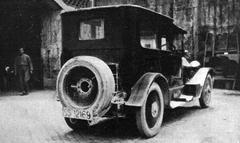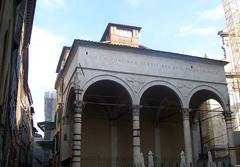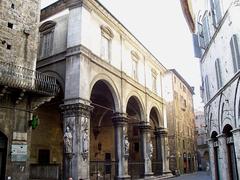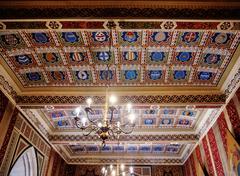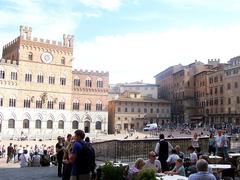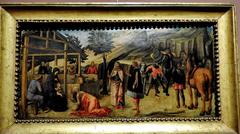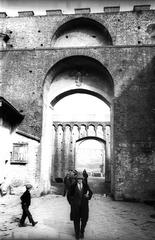Visiting Hours, Tickets, and Historical Sites of Strada dei Tufi, Siena
Date: 24/07/2024
Introduction
Strada dei Tufi, located in the historical city of Siena, Italy, offers a fascinating journey through time. Named after the ‘tufi,’ a type of volcanic rock used extensively in the construction of the road and surrounding buildings, Strada dei Tufi stands as a testament to the engineering prowess and architectural innovations of the medieval period (Wikipedia). This well-preserved road not only facilitated trade and commerce, contributing significantly to Siena’s economic development, but also played a strategic role in the city’s defense against neighboring rivals like Florence. Today, Strada dei Tufi is more than just a historic road; it is a cultural landmark that continues to attract tourists, offering guided tours, scenic views, and access to notable landmarks such as the Porta Tufi and the Church of Sant’Agostino (Trek Zone). Whether you are a history enthusiast, a cultural explorer, or a curious traveler, Strada dei Tufi promises an enriching and immersive experience into Siena’s rich heritage.
Table of Contents
Exploring Strada dei Tufi - History, Visiting Hours, and Tickets in Siena, Italy
Medieval Origins
Strada dei Tufi, located in Siena, Italy, is a historic road that dates back to the medieval period. Siena, a city renowned for its well-preserved medieval architecture, saw significant development during the 12th and 13th centuries. The road itself was part of the city’s expansion and played a crucial role in connecting Siena to the surrounding countryside and other important Tuscan cities.
Construction and Architectural Significance
The construction of Strada dei Tufi was influenced by the need for efficient transportation routes during the medieval period. The road is named after the “tufi,” a type of volcanic rock commonly used in the construction of buildings and roads in the region. This material was favored for its durability and ease of extraction. The use of tufi in the construction of Strada dei Tufi is a testament to the engineering skills of the time and reflects the broader architectural practices in Siena.
Role in Siena’s Economic Development
Strada dei Tufi was integral to Siena’s economic development during the medieval period. The road facilitated trade and commerce by providing a direct route for the transportation of goods such as wool, wine, and olive oil, which were essential to Siena’s economy. The road also connected Siena to important trade routes leading to Florence and Rome, further enhancing its economic significance.
Strategic Importance
The strategic importance of Strada dei Tufi cannot be overstated. During the medieval period, Siena was often involved in conflicts with neighboring cities, particularly Florence. The road served as a critical supply route for military campaigns and was essential for the movement of troops and equipment. Its strategic location made it a focal point in the defense of Siena, contributing to the city’s ability to withstand sieges and attacks.
Renaissance and Beyond
As Siena transitioned from the medieval period into the Renaissance, Strada dei Tufi continued to play a vital role in the city’s infrastructure. The road was maintained and improved to accommodate the increasing traffic and the evolving needs of the city. During the Renaissance, Siena experienced a cultural and artistic revival, and the road facilitated the movement of artists, scholars, and patrons who contributed to the city’s rich cultural heritage.
Modern Developments
In the modern era, Strada dei Tufi has retained its historical significance while adapting to contemporary needs. The road is now a popular route for tourists exploring Siena and its surrounding areas. Efforts have been made to preserve its historical integrity, ensuring that visitors can experience the road much as it was during its medieval heyday. The preservation of Strada dei Tufi is part of broader conservation efforts in Siena, which aim to protect the city’s unique architectural and cultural heritage.
Cultural Impact
Strada dei Tufi has also had a lasting cultural impact on Siena. The road is often featured in local folklore and traditions, reflecting its importance in the collective memory of the city’s inhabitants. Festivals and events held in Siena frequently incorporate elements of the city’s medieval past, with Strada dei Tufi serving as a backdrop for historical reenactments and celebrations.
Notable Landmarks
Several notable landmarks are located along Strada dei Tufi, each contributing to its historical and cultural significance. One such landmark is the Porta Tufi, a medieval gate that marks the entrance to the road from the city center. The gate, constructed in the 14th century, is an architectural marvel and a symbol of Siena’s medieval heritage (Wikipedia).
Another significant landmark is the Church of Sant’Agostino, located near the road. The church, built in the 13th century, is renowned for its Gothic architecture and houses several important artworks. Its proximity to Strada dei Tufi highlights the road’s importance in connecting religious and cultural sites within Siena (Trek Zone).
Preservation Efforts
Preservation efforts for Strada dei Tufi have been ongoing, with local authorities and heritage organizations working to maintain the road’s historical integrity. These efforts include regular maintenance, restoration of damaged sections, and the implementation of measures to protect the road from modern wear and tear. The preservation of Strada dei Tufi is part of a broader initiative to safeguard Siena’s historic infrastructure and ensure that future generations can appreciate its rich heritage.
Visitor Experience
Today, visitors to Siena can explore Strada dei Tufi and experience its historical significance firsthand. Walking along the road provides a unique glimpse into Siena’s medieval past, with its well-preserved architecture and scenic views of the surrounding countryside. Guided tours are available, offering insights into the road’s history and its role in the development of Siena. These tours often include visits to nearby landmarks, providing a comprehensive understanding of the road’s historical and cultural context.
Visiting Hours and Tickets
Strada dei Tufi can be visited at any time, though guided tours may have specific schedules. There are no entrance fees for walking the road, but certain landmarks along the way, such as Porta Tufi and the Church of Sant’Agostino, may have visiting hours and ticket requirements. It is advisable to check the official websites or local tourist information centers for the most up-to-date information on visiting hours and ticket prices.
Photographic Spots
Strada dei Tufi offers several picturesque spots ideal for photography. The medieval gate of Porta Tufi and the surrounding countryside provide stunning backdrops for memorable photos. Visitors are encouraged to bring their cameras and capture the unique blend of history and natural beauty that the road offers.
Conclusion
Strada dei Tufi is more than just a road; it is a living testament to Siena’s rich history and cultural heritage. From its medieval origins to its modern-day significance, the road has played a crucial role in shaping the city’s development. Its preservation ensures that visitors can continue to explore and appreciate this important piece of Siena’s past. Whether you are a history enthusiast, a cultural explorer, or simply a curious traveler, Strada dei Tufi offers a fascinating journey through time.
FAQ
Q - What are the visiting hours for Strada dei Tufi? A - Strada dei Tufi can be visited at any time. However, specific landmarks along the road may have their own visiting hours. It is recommended to check in advance.
Q - Are there any entrance fees for Strada dei Tufi? A - There are no entrance fees for walking along Strada dei Tufi, but certain sites such as Porta Tufi and the Church of Sant’Agostino may require tickets.
Q - Can I take guided tours of Strada dei Tufi? A - Yes, guided tours are available and provide valuable insights into the history and significance of the road.
Q - What are some notable landmarks along Strada dei Tufi? A - Notable landmarks include Porta Tufi and the Church of Sant’Agostino, both of which hold significant historical and cultural value.
Q - Are there good spots for photography on Strada dei Tufi? A - Absolutely. The medieval gate of Porta Tufi and the scenic views of the surrounding countryside offer excellent photographic opportunities.
Call to Action
For more information on visiting Strada dei Tufi and other historical sites in Siena, download the Audiala mobile app, check out our related posts, and follow us on social media for updates.
References
- Wikipedia, n.d., Porta Tufi, Siena https://en.wikipedia.org/wiki/Porta_Tufi,_Siena
- Trek Zone, n.d., Porta Tufi, Siena https://trek.zone/en/italy/places/222794/porta-tufi-siena
- Savoring Italy, n.d., Siena, Italy: The Ultimate Guide to the City Where Time Stands Still https://www.savoringitaly.com/siena-italy-the-ultimate-guide-to-the-city-where-time-stands-still/
